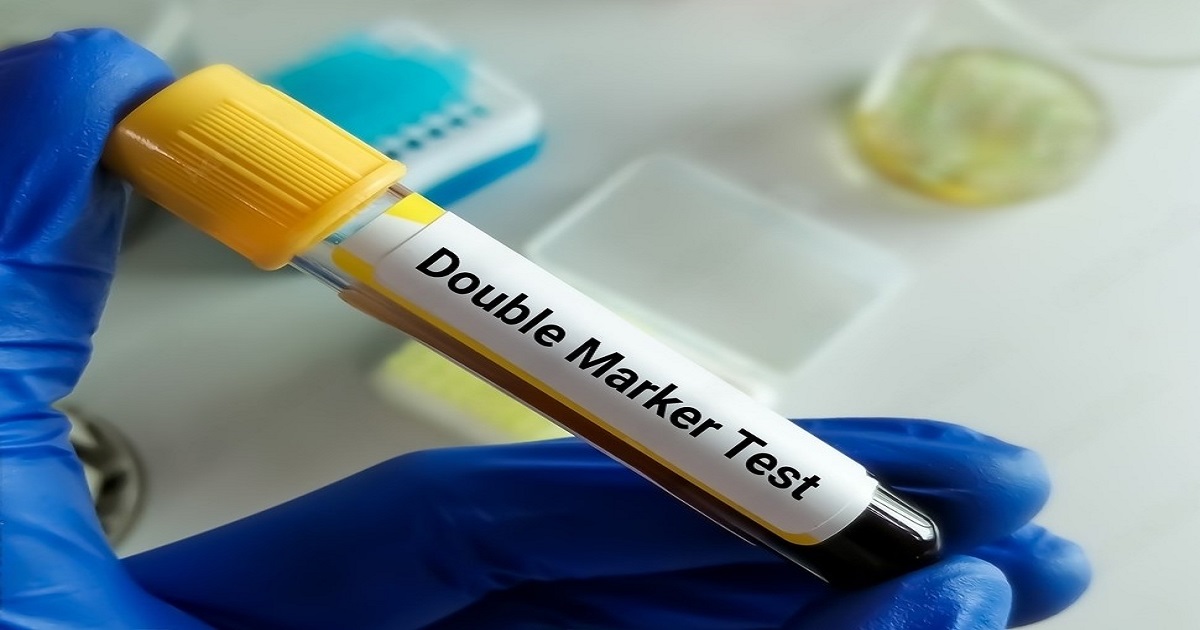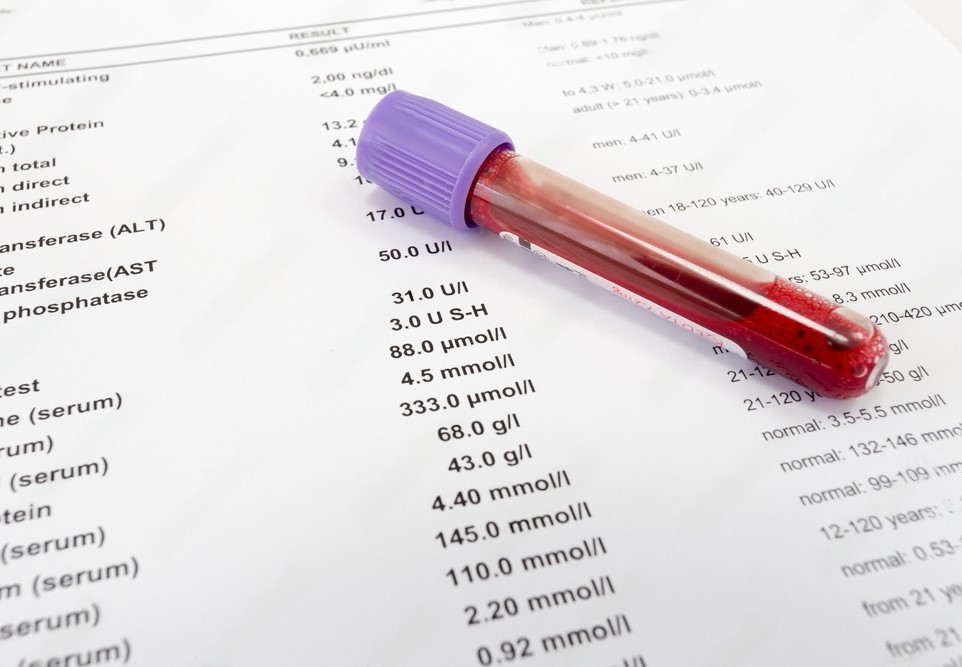What Is the Double Marker Test?
The Double Marker Test is a prenatal diagnostic test that measures two hormones in a pregnant woman’s blood to assess the risk of having a baby with Down syndrome or other chromosomal abnormalities. The test involves measuring the levels of beta-human chorionic gonadotropin (β-hCG) and pregnancy-associated plasma protein-A (PAPP-A) in a woman’s blood between 9 and 13 weeks of pregnancy. It is a safe and simple test that can provide valuable information about the health of the developing fetus.

Double Marker Test
The Double Marker Test is a blood test performed during pregnancy to assess the risk of certain chromosomal abnormalities, particularly Down syndrome (Trisomy 21) and Edwards syndrome (Trisomy 18). It measures the levels of two substances in the blood: human chorionic gonadotropin (hCG) and pregnancy-associated plasma protein-A (PAPP-A).
During pregnancy, the placenta produces these substances in specific quantities. An abnormal level of hCG or PAPP-A may indicate a higher risk of chromosomal abnormalities in the developing fetus. Therefore, the Double Marker Test helps in identifying the likelihood of such chromosomal abnormalities and helps doctors to provide proper prenatal care.
Why a Double Marker Test is done?
The Double Marker Test is usually done between 10-14 weeks of pregnancy. This is the time when the placenta starts producing hCG and PAPP-A in sufficient quantities. The test is done to identify if the developing fetus is at risk of chromosomal abnormalities.
Chromosomal abnormalities are rare but can have significant impacts on the health of the baby. Down syndrome and Edwards syndrome are two common chromosomal abnormalities that the Double Marker Test can detect. Other chromosomal abnormalities that can be detected through this test include Patau syndrome (Trisomy 13) and Turner syndrome.
Apart from detecting chromosomal abnormalities, the Marker Test can also detect the risk of other complications during pregnancy. For example, it can indicate the likelihood of miscarriage, preterm birth, or preeclampsia.
When is the Double Marker Test recommended?
The Double Marker Test is generally recommended for all pregnant women, especially those who are at high risk of having a baby with chromosomal abnormalities. Women who are over 35 years of age, have a family history of chromosomal abnormalities or have had a previous pregnancy with chromosomal abnormalities are considered high-risk and are recommended to take the test.
It is important to note that the Double Marker Test is a screening test and not a diagnostic test. This means that if the test results indicate a higher risk of chromosomal abnormalities, further diagnostic tests like Amniocentesis or Chorionic villus sampling (CVS) are required to confirm the diagnosis.
In conclusion, the Double Marker Test is a simple blood test that can help identify the likelihood of chromosomal abnormalities in the developing fetus. It is an essential part of prenatal care and can help doctors provide proper care to ensure a healthy pregnancy and delivery. If you are pregnant or planning to conceive, talk to your doctor about whether the Double Marker Test is recommended for you.
Right Time for the Double Marker Test:
The Double Marker Test is usually performed between 9 and 13 weeks of pregnancy. This is because the levels of β-hCG and PAPP-A are at their highest during this time, which allows for a more accurate assessment of the risk of chromosomal abnormalities in the developing fetus.
It is important to schedule the test at the appropriate time to ensure that accurate results are obtained. If the test is performed too early or too late, the levels of β-hCG and PAPP-A may not be accurate, which may lead to an inaccurate assessment of the risk of chromosomal abnormalities.
In conclusion, the Double Marker Test is a safe and simple screening test that can provide valuable information about the health of the developing fetus. It is usually recommended for pregnant women who are at high risk of having a baby with chromosomal abnormalities and is performed between 9 and 13 weeks of pregnancy. By understanding the purpose and timing of the Double Marker Test, women can make informed decisions about their prenatal care and the health of their developing baby.
How to Prepare for the Double Marker Test?
There is no special preparation required for the Double Marker Test. Pregnant women should continue to eat a healthy, balanced diet and stay hydrated before the test. It is also recommended to wear comfortable clothing that allows easy access to the arm for blood collection.
Before the test, it is important to inform your healthcare provider if you are taking any medications, including vitamins or herbal supplements, as they may affect the test results. It is also important to inform your healthcare provider if you have any bleeding disorders or are on blood-thinning medications, as these may affect the blood collection process.
Why Double Marker Test Done in Pregnancy?

Double Marker Test in Pregnancy
The Double Marker Test is usually recommended for pregnant women who are at high risk of having a baby with chromosomal abnormalities, including women who:
- Are over the age of 35
- Have a family history of chromosomal abnormalities
- Have had a previous pregnancy with chromosomal abnormalities
- Had a previous history of miscarriage or stillbirth
- Have abnormal results from other prenatal screening tests
The test is usually performed between 9 and 13 weeks of pregnancy because this is the ideal time to measure the levels of β-hCG and PAPP-A. These hormones are produced by the placenta, and their levels can help assess the risk of chromosomal abnormalities in the developing fetus. If the levels of β-hCG and PAPP-A are abnormal, it may indicate that the fetus is at higher risk of having a chromosomal abnormality, such as Down syndrome.
When Is the Double Marker Test in Pregnancy Required?
The Double Marker Test is recommended for pregnant women who are at high risk of having a baby with chromosomal abnormalities. It is usually offered to women who are over the age of 35, has a family history of chromosomal abnormalities, has had a previous pregnancy with chromosomal abnormalities, or have abnormal results from other prenatal screening tests.
The test is usually performed between 9 and 13 weeks of pregnancy because this is the ideal time to measure the levels of β-hCG and PAPP-A. These hormones are produced by the placenta, and their levels can help assess the risk of chromosomal abnormalities in the developing fetus. If the levels of β-hCG and PAPP-A are abnormal, it may indicate that the fetus is at higher risk of having a chromosomal abnormality, such as Down syndrome.
It is important to note that the Double Marker Test is a screening test, not a diagnostic test. If the test results indicate a high risk of chromosomal abnormalities, further diagnostic tests, such as amniocentesis, may be recommended to confirm the diagnosis.
How Is a Double Marker Test in Pregnancy Conducted?
The Double Marker Test is a simple blood test that can be performed in any laboratory. Here’s a step-by-step guide on how the test is conducted:
- Blood sample collection: The first step in conducting the Double Marker Test is to collect a blood sample from the pregnant woman. The sample is usually taken from a vein in the arm.
- Test preparation: Once the blood sample is collected, it is sent to the laboratory for testing. The sample is processed to separate the serum from the blood cells.
- Measurement of HCG and PAPP-A levels: The levels of HCG and PAPP-A are measured in the serum using an enzyme-linked immunosorbent assay (ELISA). The ELISA is a test that detects the presence of a specific substance (in this case, HCG and PAPP-A) in a sample using antibodies.
- Calculation of risk: The results of the Double Marker Test are calculated by combining the levels of HCG and PAPP-A with the woman’s age, weight, and gestational age. The combined information is used to calculate the risk of chromosomal abnormalities in the developing fetus.
- Interpretation of results: The results of the Double Marker Test are usually available within a few days. A low-risk result indicates that the likelihood of chromosomal abnormalities is low, while a high-risk result indicates that there is a higher likelihood of chromosomal abnormalities.
What to Expect from Double Marker Test Result?

Double Marker Test Result
The Double Marker Test measures the levels of two hormones, β-hCG and PAPP-A, in a pregnant woman’s blood to assess the risk of having a baby with Down syndrome or other chromosomal abnormalities. The test result is usually expressed as a ratio of the levels of β-hCG and PAPP-A.
If the Double Marker Test result is normal, it means that the risk of having a baby with chromosomal abnormalities is low. However, it is important to note that a normal result does not completely rule out the possibility of having a baby with chromosomal abnormalities.
If the Double Marker Test result is abnormal, it may indicate a higher risk of having a baby with chromosomal abnormalities, such as Down syndrome. Further diagnostic tests, such as amniocentesis, may be recommended to confirm the diagnosis.
Standard Results of Double Marker Test:
The standard results of the Double Marker Test are based on the levels of β-hCG and PAPP-A measured in a pregnant woman’s blood. The normal range for β-hCG is between 25,000 and 150,000 mIU/mL, while the normal range for PAPP-A is between 0.5 and 2.0 mIU/L.
The result of the Double Marker Test is usually expressed as a ratio of the levels of β-hCG and PAPP-A. The normal range for the ratio is between 0.5 and 2.0. A ratio higher than 2.0 or lower than 0.5 may indicate a higher risk of having a baby with chromosomal abnormalities.
It is important to note that the standard results of the Double Marker Test may vary slightly depending on the laboratory that performs the test. Your healthcare provider will interpret the test results based on the laboratory’s reference range and other factors, such as your age and medical history.
Abnormal Results of Double Marker Test:
If the Double Marker Test result is abnormal, it may indicate a higher risk of having a baby with chromosomal abnormalities, such as Down syndrome. A high level of β-hCG or a low level of PAPP-A may be associated with an increased risk of chromosomal abnormalities.
It is important to remember that an abnormal result does not necessarily mean that the baby has a chromosomal abnormality. Further diagnostic tests, such as amniocentesis or chorionic villus sampling, may be recommended to confirm the diagnosis.
It is also important to note that a high-risk result from the Double Marker Test may be due to factors other than chromosomal abnormalities, such as maternal obesity or gestational diabetes. Your healthcare provider will interpret the test results and recommend further testing or monitoring as necessary.
Also Read: How Much Does HSG Test Price/Cost in 2023?
Procedure of Double Marker Test Screening:

Procedure of Double Marker Test
The Double Marker Test (DMT) is a prenatal screening test that assesses the risk of chromosomal abnormalities in the fetus. The procedure involves a blood test that measures two specific hormones – human chorionic gonadotropin (hCG) and pregnancy-associated plasma protein-A (PAPP-A) in the mother’s blood.
The DMT is usually performed between 10 and 14 weeks of pregnancy. It is recommended for pregnant women who are at an increased risk of having a baby with Down Syndrome or other chromosomal abnormalities due to advanced maternal age, previous history of abnormal ultrasound findings, or chromosomal abnormalities.
The procedure of the DMT involves a simple blood draw from the mother’s arm. The blood sample is then sent to a laboratory for analysis. The laboratory will measure the levels of hCG and PAPP-A in the blood sample and use a specific algorithm to calculate the risk of chromosomal abnormalities in the fetus.
The test results are usually available within a few days, and the mother will be informed of the results by her healthcare provider. A low-risk result indicates a low probability of the fetus having chromosomal abnormalities. A high-risk result indicates a higher probability of the fetus having chromosomal abnormalities and may warrant further testing, such as chorionic villus sampling (CVS) or amniocentesis, to confirm the diagnosis.
Also Read: Low AMH Treatment
Risks Associated with Double Marker Test:
The DMT is considered a safe screening test with minimal risks. However, like any medical procedure, there are potential risks and limitations associated with the DMT that should be considered before undergoing the test.
- False positive or false negative results: The DMT is a screening test, and not a diagnostic test. This means that the test can give a false positive or false negative result. A false positive result indicates a high risk of chromosomal abnormalities when the fetus is actually healthy, which can cause unnecessary anxiety and lead to further invasive testing. A false negative result indicates a low risk of chromosomal abnormalities when the fetus is actually affected, which can result in missed diagnoses.
- Inconclusive results: In some cases, the DMT may yield inconclusive results due to technical or biological reasons. This can be due to low levels of HCG or PAPP-A in the mother’s blood or other factors that affect the accuracy of the test. Inconclusive results may require additional testing to confirm the diagnosis.
- Risk of miscarriage with invasive testing: If the DMT results indicate a high risk of chromosomal abnormalities, further invasive testing such as CVS or amniocentesis may be recommended. These procedures carry a small risk of miscarriage, which should be discussed with the healthcare provider before undergoing the test.
- Limited scope: The DMT can only screen for specific chromosomal abnormalities, such as Down Syndrome, Edwards Syndrome, and Patau Syndrome. It cannot screen for other genetic or structural abnormalities that may affect the fetus.
In conclusion, the Double Marker Test is a safe and effective screening test that can provide valuable information about the risk of chromosomal abnormalities in the fetus. However, it is important to discuss the potential risks and limitations of the test with a healthcare provider before undergoing the procedure.
Benefits of Double Marker Test:
The Double Marker Test (DMT) is a prenatal screening test that measures the levels of two specific hormones – human chorionic gonadotropin (HCG) and pregnancy-associated plasma protein-A (PAPP-A) – in the mother’s blood. Here are some of the benefits of the Marker Test:
- Early detection of chromosomal abnormalities: The DMT can detect the risk of chromosomal abnormalities in the fetus as early as 10-14 weeks of pregnancy. Early detection can help parents make informed decisions about their pregnancy and prepare for the birth of a child with special needs.
- Non-invasive: The DMT is a non-invasive screening test that involves a simple blood draw from the mother’s arm. There is no risk of harm to the fetus, unlike invasive tests like chorionic villus sampling (CVS) or amniocentesis.
- High accuracy: The DMT has a high accuracy rate of 90-95% in detecting the risk of chromosomal abnormalities. It can identify most cases of Down Syndrome, Edwards Syndrome, and Patau Syndrome.
- Reduced need for invasive testing: A low-risk result from the DMT means that there is a low probability of the fetus having chromosomal abnormalities, reducing the need for further invasive testing such as CVS or amniocentesis.
Also Read: Symptoms of Low AMH Level
Accuracy of Double Marker Test in India:
In India, the Double Marker Test is widely available and recommended for pregnant women who are at an increased risk of having a baby with chromosomal abnormalities. The accuracy rate of the DMT in India is similar to the global success rate, with a high accuracy rate of 90-95% in detecting the risk of chromosomal abnormalities.
However, it is important to note that the success rate of the DMT can be influenced by various factors such as the timing of the test, maternal age, and other medical conditions. It is recommended to discuss the accuracy and limitations of the DMT with a healthcare provider before undergoing the test.
Double Marker Test Price:

Double Marker Test Price
The cost of the Double Marker Test can vary depending on the location, healthcare provider, and laboratory used for the test. In India, the cost of the DMT can range from Rs. 2000 to Rs. 5000.
It is important to check with the healthcare provider and insurance provider, if applicable, about the cost and coverage of the DMT before undergoing the test. Some hospitals and clinics may offer discounts or packages for prenatal screening tests, including the Double Marker .
In conclusion, the Marker Test is a valuable prenatal screening test that can provide early detection of the risk of chromosomal abnormalities in the fetus. It is a non-invasive, accurate, and widely available test in India. The cost of the DMT can vary, and it is recommended to discuss the cost and coverage with a healthcare provider and insurance provider, if applicable.
Also Read: Is IVF With Low AMH Possible?
Difference between a Double Marker Test, NT scan and Triple marker test:
| Test Name | What it Measures | When it’s done | How it’s done |
| Double Marker Test | Measures levels of two hormones in the mother’s blood: free beta-human chorionic gonadotropin (β-hCG) and pregnancy-associated plasma protein-A (PAPP-A). | Between 10-14 weeks of pregnancy | Blood test |
| NT Scan | Measures the thickness of fluid at the back of the baby’s neck, called nuchal translucency. | Between 11-14 weeks of pregnancy | Ultrasound |
| Triple Marker Test | Measures levels of three hormones in the mother’s blood: alpha-fetoprotein (AFP), free beta-human chorionic gonadotropin (β-hCG), and unconjugated estriol (uE3). | Between 15-20 weeks of pregnancy | Blood test |
Each of these tests provides different information about the health of the fetus and the risk of certain chromosomal abnormalities or birth defects. The double marker test and triple marker test are commonly used to screen for Down syndrome, while the NT scan can also detect other abnormalities like heart defects or genetic disorders.
Also Read: NT NB Scan
How is the Double Marker Test sample collected?
The Double Marker Test sample is collected through a simple blood draw. Here’s what you can expect during the sample collection process:
- Preparation: Before the blood draw, the healthcare provider will clean the area where the needle will be inserted with an antiseptic.
- Blood draw: The healthcare provider will use a sterile needle to draw blood from a vein in your arm. You may feel a slight pinch or prick as the needle is inserted.
- Blood collection: The blood will be collected in a small vial and labelled with your name and other identifying information.
- Post-collection care: After the blood draw, you may be asked to apply pressure to the area with a cotton ball or bandage to help stop the bleeding. You should avoid heavy lifting or strenuous activity for a few hours after the blood draw to minimize the risk of bruising.
the Marker Test is a simple blood test that can be conducted in any laboratory. It involves collecting a blood sample from the pregnant woman and measuring the levels of HCG and PAPP-A to assess the risk of chromosomal abnormalities in the developing fetus.
Also Read: Dual Marker Test
FAQ:
Q: What if Double marker test is positive?
A: If the Double Marker Test is positive, it means that the test has detected a high risk of chromosomal abnormalities in the fetus. Further testing, such as amniocentesis or chorionic villus sampling, may be recommended to confirm the diagnosis and determine the best course of action for the pregnancy.
Q: In which month double marker test is done?
A: The Double Marker Test is typically done between 10-14 weeks of pregnancy.
Q: डबल मार्कर टेस्ट क्या है?
A: डबल मार्कर टेस्ट एक प्रसवपूर्व स्क्रीनिंग टेस्ट है जो मां के खून में दो विशिष्ट हार्मोनों के स्तरों – मानव गर्भावस्था गोनाडोट्रोपिन (hCG) और गर्भावस्था संबंधी प्लाज्मा प्रोटीन-ए (PAPP-A) – को मापता है।
Q: Does double marker test show baby’s gender?
A: No, the Double Marker Test does not show the baby’s gender. It is a screening test used to detect the risk of chromosomal abnormalities in the fetus.
Q: Is Double marker and NT scan same?
A: No, the Double Marker Test and NT (nuchal translucency) scan are not the same. The Marker Test measures the levels of hCG and PAPP-A in the mother’s blood, while the NT scan measures the thickness of the fluid at the back of the fetus’s neck.
Q: Why do doctors suggest double marker tests?
A: Doctors suggest double marker tests to detect certain chromosomal abnormalities and genetic disorders in the developing fetus. This test helps to identify any potential risks for Down syndrome and other genetic conditions, allowing for early detection and treatment if necessary.
Q: What is double marker test cost?
A: The cost of a double marker test can vary depending on the location and healthcare provider. In general, the cost of the test can range from around $30 to $150. It’s best to check with your doctor or healthcare provider for more specific information about the cost of the test in your area.
Q: Can I skip double marker test?
A: While the double marker test is not mandatory, it is strongly recommended by doctors and healthcare professionals. Skipping the test can increase the risk of not detecting potential chromosomal abnormalities or genetic disorders in the developing fetus, which can have serious health consequences for both the fetus and the mother.
Q: When is NT scan and marker test done?
A: The NT (nuchal translucency) scan and double marker test are typically done between the 11th and 14th week of pregnancy. These tests are used together to assess the risk of chromosomal abnormalities and genetic disorders in the developing fetus.
Q: When is the anomaly scan done?
A: The anomaly scan, also known as the fetal anatomy scan, is typically done between the 18th and 22nd week of pregnancy. This scan is used to check the baby’s growth and development, and to identify any physical abnormalities or structural defects in the fetus.
Q: What is the use of double marker?
A: The double marker test is used to assess the risk of chromosomal abnormalities and genetic disorders in the developing fetus, such as Down syndrome. It measures two specific proteins in the mother’s blood – free beta hCG and PAPP-A – and combines the results with the mother’s age to determine the likelihood of the fetus having a chromosomal abnormality.
Q: What if double marker test is negative?
A: A negative result on the double marker indicates a lower likelihood of the fetus having a chromosomal abnormality. However, it does not guarantee that the fetus is free from any genetic disorders or developmental abnormalities.
Q: What is double marker test cost?
A: The cost of a double marker test can vary depending on the location and healthcare provider. In general, the cost of the test can range from around $30 to $150. It’s best to check with your doctor or healthcare provider for more specific information about the cost of the test in your area.
Q: Can I skip double marker test?
A: While the double marker test is not mandatory, it is strongly recommended by doctors and healthcare professionals. Skipping the test can increase the risk of not detecting potential chromosomal abnormalities or genetic disorders in the developing fetus, which can have serious health consequences for both the fetus and the mother.
Q: Is dual marker test necessary?
A: The dual marker test, which is similar to the double marker test, is not considered necessary for all pregnant women. However, it may be recommended by doctors or healthcare providers in certain cases, such as if the mother is over the age of 35 or if there is a family history of chromosomal abnormalities or genetic disorders.
Q: In which week of pregnancy double marker test is done?
A: The double marker is typically done between the 11th and 14th week of pregnancy.
Q: What is MoM values in pregnancy?
A: In pregnancy, MoM (multiple of the median) values are used to compare the levels of certain proteins in the mother’s blood to the normal range for that protein in a large population of pregnant women. This helps to determine the likelihood of the fetus having a chromosomal abnormality or genetic disorder.
Q: Are Double marker and Down syndrome the same?
A: The marker test is a screening test used to assess the risk of chromosomal abnormalities and genetic disorders in the developing fetus, including Down syndrome. However, a positive result on the double marker does not necessarily mean that the fetus has Down syndrome, and further testing may be needed to confirm a diagnosis.
Q: What happens if the Down syndrome test is positive?
A: If a Down syndrome test is positive, further diagnostic testing such as amniocentesis or chorionic villus sampling may be recommended to confirm the diagnosis. The parents will then receive counselling and support to help them make decisions about the pregnancy.
Q: What if the triple marker test is negative?
A: A negative result on the triple marker test indicates a lower likelihood of the fetus having certain chromosomal abnormalities and neural tube defects. However, it does not guarantee that the fetus is free from any genetic disorders or developmental abnormalities, and further testing may be recommended if there are any concerns or risk factors present.


